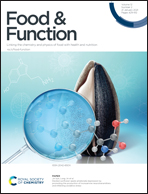Purification and characterization of immunomodulatory peptides from enzymatic hydrolysates of duck egg ovalbumin†
Abstract
Duck egg white (DEW) is considered as an abandoned protein resource. For a higher-value utilization, preparation of immunomodulatory peptides from the extracted ovalbumin in DEW was explored. Among the hydrolysates catalyzed by five proteases, papain hydrolysate (PH) shows the highest degree of hydrolysis and the strongest immunomodulatory activity. PH could significantly enhance the phagocytic capacity and promote the NO, TNF-α, and IL-6 secretion of RAW 264.7 cells, involving toll-like receptor 2 and 4. After purification, nine identified peptides were synthesized to confirm the immunomodulatory effect, and five of them exhibit a strong activity. The peptide, TQIDKVVHFDKLPGF, presents the highest immunomodulatory activity. Moreover, the results of molecular docking indicate that nine peptides interacted with toll-like receptor 2 and 4 and all show good affinity. Furthermore, three peptides with high affinity and strong immune activity were selected for interaction site map analysis. Three peptides could form hydrogen bonds with the receptor and bind stably, which contributes to the immunomodulatory activity of the peptide. Results suggest that DEW can be a promising source of immunomodulatory peptides.



 Please wait while we load your content...
Please wait while we load your content...